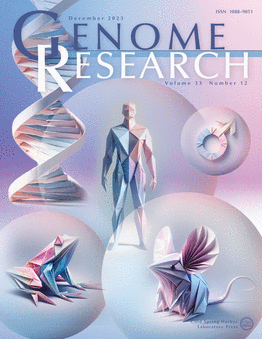水稻核细胞器DNA的持续浸润和进化轨迹
IF 5.5
2区 生物学
Q1 BIOCHEMISTRY & MOLECULAR BIOLOGY
引用次数: 0
摘要
叶绿体或线粒体DNA转移到核基因组中是许多物种的普遍现象。然而,对高等植物细胞器DNA序列转移的进化命运和机制知之甚少。研究人员在7种稻属植物的22个基因组片段的核基因组中发现了大量的细胞器DNA插入,并将细胞核细胞器DNA (NORG)进一步划分为3406个同源基团。通过对3458个玉米品种的全基因组重测序数据的分析表明,在进化过程中,由于序列丢失和转座子插入,norg具有种群内和种群间的变异性。我们的研究结果还表明,norg在Oryza的进化过程中不断产生,双链断裂修复途径和基于复制的机制在细胞器DNA整合到核基因组中发挥了重要作用。进一步的研究表明,复杂的norg是通过多个质体和/或线粒体DNA相互连接在插入过程之前或过程中的单个突变事件形成的。综上所述,本研究对内共生DNA转移过程及其在重塑基因组变异和植物基因组进化中的作用提供了新的见解。本文章由计算机程序翻译,如有差异,请以英文原文为准。
Continuous infiltration and evolutionary trajectory of nuclear organelle DNA in Oryza
Transfer of chloroplast or mitochondrial DNA into the nuclear genome is a common phenomenon in many species. However, little is known about the evolutionary fate and mechanism of transfer of organellar DNA sequences in higher plants. We observe abundant insertions of organelle DNA into the nuclear genomes of 22 genome assemblies across seven Oryza species and further categorize nuclear organelle DNA (NORG) into 3406 orthologous groups. Analysis of the whole-genome resequencing data from 3458 O. sativa, O. glaberrima, and O. barthii accessions indicate that NORGs have intra- and inter-population variability owing to sequence loss and transposon insertion during evolution. Our results also suggest that NORGs have been continuously produced during the evolution of Oryza, and both double-strand break repair pathways and replication-based mechanisms play important roles in integrating organelle DNA into the nuclear genome. Further investigation indicates that complex NORGs are formed through single mutational events before or during the insertion process via ligation of multiple plastid and/or mitochondrial DNA with each other. In summary, this work provides novel insights into the process of endosymbiotic DNA transfer and its role in reshaping genome variation and plant genome evolution.
求助全文
通过发布文献求助,成功后即可免费获取论文全文。
去求助
来源期刊

Genome research
生物-生化与分子生物学
CiteScore
12.40
自引率
1.40%
发文量
140
审稿时长
6 months
期刊介绍:
Launched in 1995, Genome Research is an international, continuously published, peer-reviewed journal that focuses on research that provides novel insights into the genome biology of all organisms, including advances in genomic medicine.
Among the topics considered by the journal are genome structure and function, comparative genomics, molecular evolution, genome-scale quantitative and population genetics, proteomics, epigenomics, and systems biology. The journal also features exciting gene discoveries and reports of cutting-edge computational biology and high-throughput methodologies.
New data in these areas are published as research papers, or methods and resource reports that provide novel information on technologies or tools that will be of interest to a broad readership. Complete data sets are presented electronically on the journal''s web site where appropriate. The journal also provides Reviews, Perspectives, and Insight/Outlook articles, which present commentary on the latest advances published both here and elsewhere, placing such progress in its broader biological context.
 求助内容:
求助内容: 应助结果提醒方式:
应助结果提醒方式:


